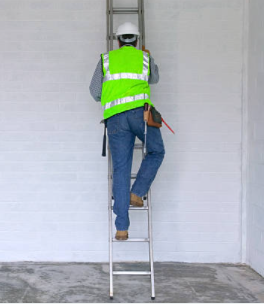By Mike Marr, Safety Technical Resources Consultant
Over the past few years BWC has promoted National Ladder Safety Month to promote ladder safety and help people recognize what causes ladder accidents. We want to help workers recognize unsafe practices when it comes to ladder use.
The American Ladder Institute, along with many other organizations like BWC, promotes the safe use of ladders to help businesses prevent ladder-related injuries among their employees. According to the World Health Organization, the United States leads the world in ladder deaths. There are more than 164,000 emergency room visits and 300 deaths caused by falls from ladders in the U.S. each year1.
The statistics go on to tell us that most ladder deaths are from falls of 10 feet or less1. Over the past decade the number of people that have died from falling off ladders has tripled1. Falls are the second leading cause of death on the job next to vehicle crashes2.
There are numerous things to remember when using ladders. The following list contains important tips to remember when using all ladders:
- Select the right ladder for the task you are doing. (Consider the capacity chart below)
| Duty rating | Type | Weight rating (lbs.) |
| Light | III | 200 |
| Medium | II | 225 |
| Heavy | I | 250 |
| Extra heavy | IA | 300 |
| Extra heavy | IAA | 375 |
- Always inspect ladders before using.
- Damaged ladders should be pulled from service.
- Always keep belt buckles between the side rails and face the ladder.
- Maintain 3-points of contact (two hands and a foot, or two feet and a hand) when climbing or descending a ladder.
- Always watch for overhead power lines.
- Make sure that ladders are setup on a stable surface.
- Ladders should not be painted as this can cover up damaged areas.
- Use ladders only for the purpose they were designed. For example, do not lean a folded stepladder against a wall like a single ladder.
- Never move or shift a ladder with a person or equipment on the ladder.
When using Step Ladders there are certain things to be aware of:
- Make sure the spreaders are locked.
- Never use the top step or cap as a step.
- Never use cross bracing on the rear of stepladders for climbing.
- Never leave tools, materials, or equipment on a stepladder.
- Never use a stepladder horizontally like a platform.
When using Single or Extension Ladders there are items to consider as well:
- When setting up longer ladders it may be necessary to have a second person help raise and lower the ladder.
- Make sure you have the correct angle for your ladder. Set at 4 to 1, one foot out for every 4 feet up.
- If you are going to step off the top of an extension ladder, make sure it is secured in place and extends 3 feet above the landing surface.
- When setting the height of the extension ladder make sure the locking device is secured.
While some of these reminders may seem obvious, it’s important to keep things in perspective. Most adults have used a ladder at some point in their lives, whether at home or at work. It may be for something as simple as changing a light bulb but use of a ladder can be anything but harmless. We all have or will have the potential for ladder-related injuries if we don’t think about ladder safety.
So, during this Ladder Safety Month, consider promoting ladder safety at your workplace.
For additional information about ladder safety, view BWC’s Safety Talk on Portable Ladder Safety in English or Spanish.
NIOSH’s Ladder Safety App is a great way to ensure that ladders are set up properly, you can download this free app to your smart device.
1 Ladder Safety | International Association of Certified Home Inspectors
